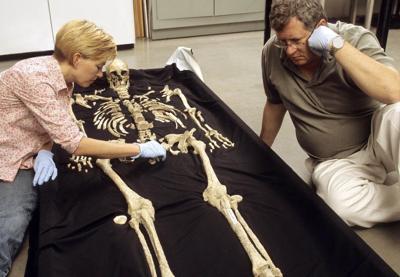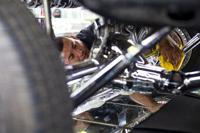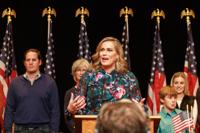Twenty-five years ago this week, two men trying to catch a glimpse of hydroplane races in the Tri-Cities made a discovery that would trigger a 20-year legal battle between Native Americans and scientists.
The controversy over the Ancient One, who was also called Kennewick Man when he was first discovered, pitted oral tradition against science, and ending with science validating the Native American belief that their people populated the Columbia Plateau for millennia.
The Ancient One’s modern odyssey began July 28, 1996, when two men, Will Thomas and Dave Deacy, were wading along the Columbia River’s bank near Kennewick during the Water Follies. Some accounts say the men were trying to avoid the gate fee for the event’s hydroplane races.
Thomas, wading about 10 feet from the bank, hit something underwater that he thought was a rock. Instead, what he pulled up was a human skull, complete with teeth. The men stashed the skull along the riverbank, watched the boat races and then went to police with their find.
While authorities initially thought the skull could have belonged to either a drowning or homicide victim, then-Benton County Coroner Floyd Johnson thought the remains looked unusually old. He enlisted help from James Chatters, a self-employed anthropologist, who then scoured the riverbank where the skull was found, eventually finding more than 350 bones and fragments.
A month later, Chatters announced at a news conference that the nearly complete skeleton was more than 9,000 years old, based on radiocarbon dating (subsequent studies would roll back that estimate to 8,500 years) and that there was a stone spear point embedded in the man’s pelvis.
But Chatters said that, based on measurements of the skull, the Ancient One more closely resembled Europeans than Native Americans. Despite Chatters’ assertion that he was not saying Europeans were the first settlers of the North American continent, it didn’t stop the speculation.
One reconstruction of the skull’s facial features resembled British actor Sir Patrick Stewart.
That suggestion did not sit well with Native Americans, who insisted from the beginning that the Ancient One was an ancestor and needed to be returned to them for reburial under the terms of the Native American Graves Protection and Repatriation Act.
The 1990 act required that remains in museum collections be returned to the tribes with which they were affiliated, as well as declaring that any remains discovered on federal land belonged to the tribe with the closest affiliation.
Armand Minthorn, a member of the Confederate Tribes of the Umatilla Indian Reservation’s board, raised the first challenge, as the Umatilla were the closest tribe to where the remains were found.
He was joined by representatives of the Yakama Nation in asking the U.S. Army Corps of Engineers, whose jurisdiction included the burial site, to ensure the bones were not further tested.
“How would you feel if we came into your cemetery and dug up your ancestors?” Minthorn asked in a 1996 interview with The Seattle Times.
The corps took possession of the remains, which were held at the Pacific Northwest National Laboratory in Richland while the dispute was sorted out. The Umatilla, Yakama, Colville, Wanapum and Nez Perce tribles made a formal request that they be repatriated.
The corps gave public notice Sept. 17, 1996, that it would repatriate the remains, but Chatters had contacted other anthropologists and archaeologists to challenge the order, arguing that the repatriation act was a threat to the study of the origins of Native Americans.
A month later, eight scientists filed suit in U.S. District Court in Portland to block the repatriation and gain access to the remains for study. They argued that the age of the remains and the near completeness of the skeleton and an apparent lack of resemblance to Native Americans made the discovery significant and one that should be studied.
During the trial, the custody of the remains was transferred from the corps to the U.S. Department of Interior, and they were placed at court order at the University of Washington’s Burke Museum, which was deemed a neutral repository.
At that time, no suitable DNA samples were able to be obtained from the Ancient One, but scientists said bone measurements showed the remains more strongly resembled Polynesians, with some characteristics of Native Americans, Europeans and Asians as well.
On Aug. 30, 2002, rejecting an Interior Department order to repatriate the bones, Magistrate Judge John Jelderks ruled that the repatriation act did not apply since scientific studies showed no relationship between the tribes and the Ancient One, and that oral traditions — which Minthorn said went back 10,000 years — were not sufficient evidence to justify repatriation.
The ruling was affirmed by the Ninth Circuit Court of Appeals, and both sides opted not to go to the U.S. Supreme Court for fear of setting a bad precedent for either side.
After that, studies commenced on the remains, and Native Americans regularly visited the museum to perform ceremonies on the Ancient One’s behalf. During that time, the remains were never displayed publicly.
In 2014, Richard Jantz and Douglas Owsley, two of the scientists who went to court, edited theirs and their colleagues’ findings in the book “Kennewick Man: The Scientific Investigation of an Ancient American Skeleton” and asserted that the remains were more closely related to Polynesians and other Pacific nations than Native Americans.
Within a year, scientists in Denmark definitively refuted that assertion and validated what the Yakama and other Native people had said all along.
Taking advantage of advancements in DNA technology, a team at the University of Copenhagen announced in June 2015 that the Ancient One was more closely related to Native Americans than any other group, and that the Colville tribe shared ancestry with him.
Scientists at the University of Chicago verified the results in April 2016, and the repatriation process began again, with the tribes having to establish cultural connections with the Ancient One.
But this time, Congress stepped in, not to stop the repatriation but to move it along more quickly. U.S. Sen. Patty Murray and U.S. Rep. Denny Heck, both Washington Democrats, sponsored the “Bring the Ancient One Home Act of 2015,” requiring the remains be repatriated within 90 days.
U.S. Rep. Dan Newhouse, a Sunnyside Republican whose district includes the area where the Ancient One was found, also supported the bill, and with Murray attached it to the Water Infrastructure Improvements for the Nation Act, guaranteeing its passage.
President Barack Obama signed the act into law in December 2016, calling for the Ancient One to be transferred to the state Department of Archaeology and Historic Preservation, which would in turn transfer the remains back to the tribes.
On Feb. 17, 2017, representatives of the five tribes met at the Burke Museum to receive the remains, including vials of DNA samples taken from them and the spear point, and they drove to Richland. The next day, representatives of the tribes went to an undisclosed location in the Columbia Plateau’s high desert to rebury the remains in a Washat ceremony.
“The return of our ancestor to Mother Earth is a blessing for all Yakama people,” then-Yakama tribal Chairman JoDe Goudy said in a news release. “The Ancient One ... may now finally find peace, and we, his relatives, will equally feel content knowing that this work has been completed on his behalf.”









(0) comments
Comments are now closed on this article.
Comments can only be made on article within the first 3 days of publication.